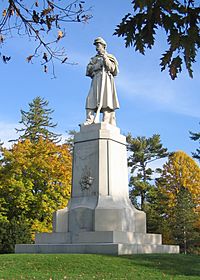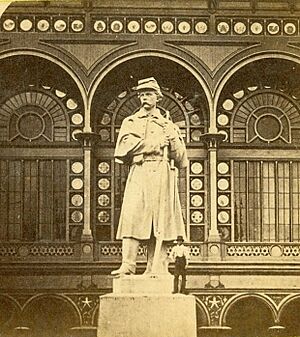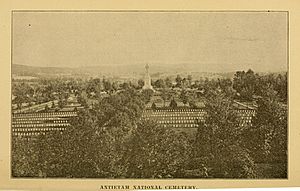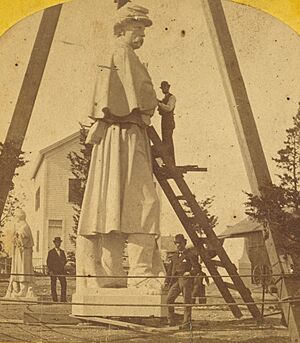The American Volunteer (statue) facts for kids
Quick facts for kids The American Volunteer |
|
|---|---|
| U.S. Soldier Monument, Private Soldier Monument | |
 |
|
| Artist | Carl Conrads, sculptor George Keller, architect |
| Year | completion 1876 dedication 1880 |
| Type | Granite |
| Dimensions |
|
| Location | Antietam National Cemetery Sharpsburg, Maryland United States |
| 39°27′33″N 77°44′28″W / 39.45917°N 77.74111°W | |
| Owner | National Park Service |
The American Volunteer is a huge granite statue. It sits on top of the U.S. Soldier Monument at Antietam National Cemetery in Sharpsburg, Maryland. People also call it The American Soldier or the Private Soldier Monument.
The monument was designed by sculptor Carl Conrads and architect George Keller. They worked for the New England Granite Works. The statue was shown at the 1876 Centennial Exposition in Philadelphia, Pennsylvania. It was called "the largest work of its kind in the country." In 1880, it was moved to Sharpsburg and placed on the monument. The whole project cost over $32,000. The statue's nickname is "Old Simon".
Planning the Monument
The first stone for the monument was laid on September 17, 1867. This was the fifth anniversary of the Battle of Antietam. It happened during the opening ceremonies for Antietam National Cemetery.
Many important people were there. These included President Andrew Johnson, judges from the Supreme Court of the United States, and members of the U.S. Congress. Generals like General Grant and General McClellan also attended.
The night before, the Antietam National Cemetery Board approved the monument's design. It showed a large U.S. soldier wearing an overcoat and a cap (kepi). He holds his rifle in a "parade rest" pose. We don't know how the design was chosen. It's unclear if the committee asked for something specific or if the designers suggested it first.
Making the Statue
The granite for the statue came from the Rhode Island Granite Works. This company was part of the New England Granite Works. The statue was carved there by a team led by James W. Pollette.
The statue was made in two parts. The soldier's belt hides where the two pieces join. A tree stump behind the figure helps to make it stable.
The soldier's pose was special for its time. Instead of standing perfectly straight, the soldier is in a relaxed "parade rest" pose. Other sculptors had used this pose before. But Conrads's soldier is alert and looking out. After The American Volunteer became popular, this "parade rest" pose became common for Civil War monuments.
Conrads used a similar design for other soldier statues. These include monuments in Portland, Connecticut (1871–72) and Meriden, Connecticut (1873). His statue in Wolcottville (1879) was also based on the Antietam model.
Before the statue went to the Centennial Exposition, a company took photos of it. This was probably to get people excited about its public debut.
At the Centennial Exposition

The statue likely arrived at the Centennial fairgrounds by train. It came in two pieces. The fair was held in Philadelphia in 1876.
The huge statue was placed on a 15-foot granite base. It stood in front of the Main Exhibition Building. This building was the largest in the world at the time. On May 10, 1876, President Grant opened the fair while facing the statue.
Over 10 million people visited the Exposition. That was one-fifth of the U.S. population back then! Almost everyone saw the statue. Many more saw it in pictures. Even though its official name was "The American Soldier," people started calling it "The American Volunteer." This new name became popular because of widely shared photos.
One art critic wrote about the statue. He said it was "hard and firm though alert." He wondered how artists made such a huge figure from granite so quickly. He noted that ancient Egyptian sculptors took years to make similar statues. But American artists used new tools and finished it in months. He described the soldier as "rocky, rude and large-grained." He also said the soldier looked like a "sentinel not to be trifled with."
The forearm of the Statue of Liberty was also at the 1876 Exposition. People could go inside it to help raise money for the rest of the statue. But The American Volunteer was arguably more famous at that time. This was before "Lady Liberty" was finished in Paris in 1884.
Arriving at Antietam
There was one big problem during transport. The top half of the soldier fell into the Potomac River while being unloaded. But it was recovered! The statue was then moved by canal barge to Sharpsburg. From there, it was rolled to the National Cemetery.
The statue was placed on a new, taller base. Architect George Keller is believed to have designed this base. The monument was officially dedicated on September 17, 1880. This was the eighteenth anniversary of the battle.
George Hess was the first superintendent of Antietam National Cemetery. In 1890, he wrote about the monument. He said it was "the colossal statue of an American soldier standing guard." It watches over the graves of soldiers buried around it. The monument has an inscription that says: "Not for Themselves, but for Their Country, September 17, 1862."

- David F. Ransom, George Keller, Architect (Hartford: The Stowe-Day Foundation, 1978).








